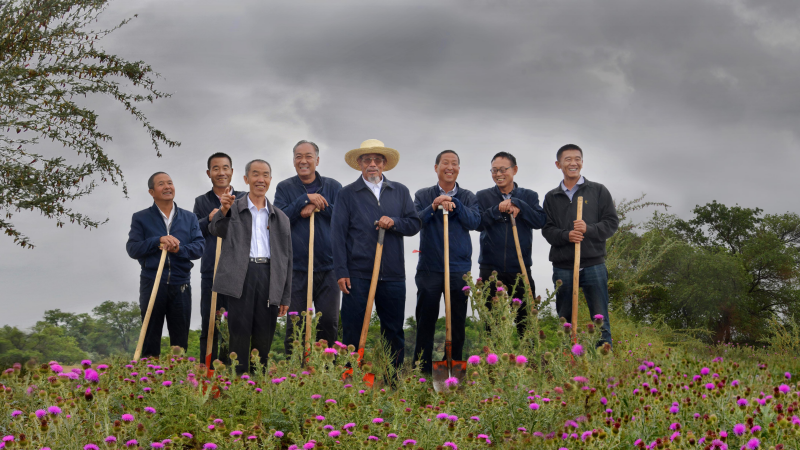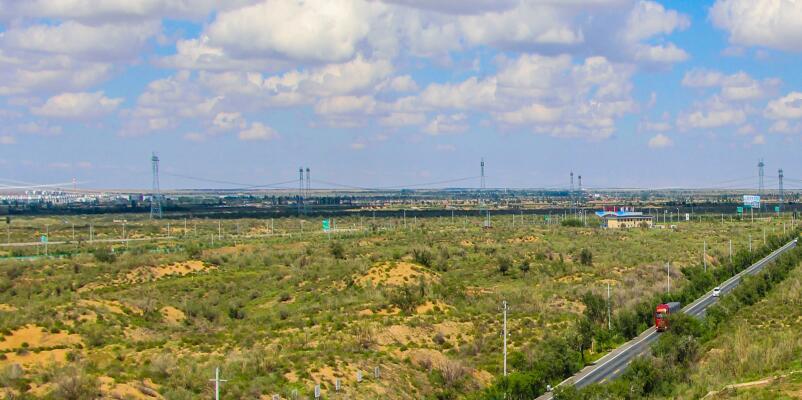Overview of the project:
Gulang County, located on the southern edge of northwest China’s Tengger Desert at the eastern end of a narrow swath of relatively arable land west of the Yellow River’s Ordos Loop known as the Hexi Corridor, consists of 160,000 ha of desert and a 132-km-long sandstorm corridor and is thus one of China’s key desertification monitoring areas. Originally an isolated track of sand dunes between Gulang’s Tumen and Dajing Towns, what is now known as Babusha Forest Farm, used to be full of sandstorms and other problems. More than 40 years ago, the desert was expanding southward at the rate of 7.5 meters per year, which threatened more than 1,333 ha of arable land and had a serious impact on the livelihoods and living conditions of the people residing in the 10-plus villages in the immediate area and the more-than-30,000 people inhabiting the surrounding area.
Commonly referred to as the Great Green Wall, a program consisting of windbreaking strips of forest and other vegetation designed to halt the expansion of the Gobi Desert and provide various forestry and agricultural products being planted until around 2050 in the north, northeast, and northwest parts of the country officially known as the Three-North Shelter Forest Program was launched in 1978. Feeling inspired, the six elderly residents of Gulang’s Tumen Commune established Babusha and implemented a Contract Responsibility System covering 5,000 ha of desert in 1981, which marked the formal beginning of the long, arduous desertification control and greening campaign in the area. The hard work that three generations of eco-warriors have engaged in has resulted in the area transforming from a desert that lacked even grass plants into a fertile emerald that enables locals to increase their incomes and become more prosperous.
Approaches and methodology:
● Various desertification prevention and control models and techniques have been explored and implemented in Gulang over the years.
Third generation eco-warriors, such as Guo Xi and Chen Shujun, have utilized new techniques involving elements such as “grass grids, drip irrigation, and plastic mulching” and promoted mechanized and digitalized desertification control methods, which has saved time and substantially reduced costs. A pile driver, for example, can drive 1,500 to 2,000 holes that trees and shrubs can be planted in per day, which is over 10 times what can be achieved manually, while easy-to-operate, optimized walk-behind sand barrier machines can be used on various types of terrain and are four to six times more efficient than manual sowing. The third generation also implemented an “internet + desertification control” system in line with the Internet Plus strategy of applying the internet and other information technologies to various industries and undertakings in order to update them and facilitate business development proposed by the Chinese government in 2015 thatleverages social capital and crowdfunding in order to address the problem of insufficient funding and enhance their campaign.

Three generations of eco-warriors in Babusha
● Development of Desert Industries
Market mechanisms were introduced, management has been enhanced, and a multi-channel, multi-directional cooperation system was created. Gulang County Babusha Greening Co. Ltd. was established in 2009 in order to harness Babusha Forest Farm’s economic resources, and an industrial development model involv-ing “the company + a base + farmers” and a management system that includes “land rights transfers, benefit sharing, large-scale operations, and industrialized development” were implemented.The enterprise spent US$1.94 million (13 million yuan) leasing 833 ha of land from people living in the area and planting saxaul, wolfberries, and red dates and grafting sand crops, such as des-ert-broomrape, onto the saxaul on it in order to combine desertifi-cation control with industry.
● Characteristic brands have been built, and marketing has been up-leveled. Funding was introduced, a chicken farm was constructed, a green brand known as Babusha Free-Range Chicken was established, Babusha Forest Farm’s unique natural and geo-graphical conditions have been utilized and the under-forest econ-omy has been vigorously developed, and job opportunities have been created for impoverished locals.
● Advantageous resources have been leveraged, and a new eco-tourism model was created. Gulang has actively pursued rural tourism, developed desertification control experience bases, launched high-quality tourism routes, and created an ecotourism area integrating education and training, ecological research, oasis tourism, and leisure in conjunction with Babusha Forest Farm.
Results:
● Remarkable ecological desertification control achievements have been made. The three generations of eco-warriors who have worked in the area have greened a total of 17,133 ha of barren land and protected 28,667 ha of land. Their efforts have resulted in a sand-fixing, wind-proof green corridor spanning 10 km from north to south and 8 km from east to west forming as the green rate in the area increased from less than 3% to over 70%, which has safeguarded more than 60,000 people and nearly 6,667 ha of farmland in the three surrounding towns.
● Locals have increased their incomes and become more prosperous by unlocking the power of the ecological resources that exist in the area. A total of 833 ha’s land rights have been transferred, profit-generating wolfberry plants have been sown on 500 ha of land, 707 ha of saxaul shrubs that desert-broomrape plants were later grafted onto have been planted, and more than 700 temporary jobs that result in an average of an extra US$1,194 (8,000 yuan) of annual income per year have been created for locals who were impoverished prior to getting involved at the desert forest as of June 2022. Babusha Forest Farm’s fixed assets increased from US$298,507 (2 million yuan) and the average annual income of its employees increased from less than US$447 (3,000 yuan) in 2010 to more than US$2.98 million (20 million yuan) and US$10,448 to US$11,940 (70,000 to 80,000 yuan), respectively, in 2022.
● A social atmosphere in which the public is concerned with, supports, and participates in desertification prevention and control has taken root. In recent years, more than 10,000 tourists and members of various organizations from all walks of life have volunteered to participate in desertification control and greening in the area. Third generation eco-warriors have been able to invest more than US$11.34 million (76 million yuan) in sowing a total of more than 14 million plants of various types across 9,333 ha of desert by leveraging the internet and various engineering technologies in conjunction with a campaign launched on the Alipay mobile client that results in trees being planted when users engage in activities that reduce carbon emissions known as the Ant Forest project.
Lessons Learned:
● It is important that local residents’ intrinsic motivation to protect and harness the natural environment is fully awakened when engaging in this type of undertaking, as their recognition and sup-port are necessary. The three generations of “six elderly men” who founded and have developed Babusha have acted as desertification prevention and control role models and representatives. These kinds of role models have the ability to appeal to people’s identities, generate more emotional resonance and value recognition, and inspire participation in the cause of combating desertification.
● Environmental governance should be conducted in a manner that is fully cognizant of local conditions, advances with the times and leverages technology. The three generations of people who have worked at Babusha have utilized approaches that are suited to local conditions, adopted desertification control techniques suited to the local environment, and have heightened the application of science and technology and promoted mechanization, which has improved efficiency and boosted outcomes.

A view of the lush vegetation and greenery and well-pro-tected roads and railways in Babusha today
● The economic possibilities that an environment contains can be unlocked, and value chains can be reinvented. Determined to turn the desert into an oasis, three generations of eco-warriors have devoted themselves to desertification control and greening for more than 40 years, which has altered the situation from one in which people retreated from the desert to one in which they are advancing and made it possible for the desert to become an asset that generates capital. A model in which saxaul shrubs are planted and desert-broomrape plants are later grafted onto them has been utilized, and a new value chain that combines desertification control with industrial development and economic development has been created.
Related Link:
New Generation of Eco-warriors at Babusha Forest Farm
http://www.wfpchinacoe.net/2023-01/06/content_85041707.shtml
Category
Desertification Control at Babusha Forest Farm
Contributor
Desertification Control at Babusha Forest Farm
Country
Case Study

